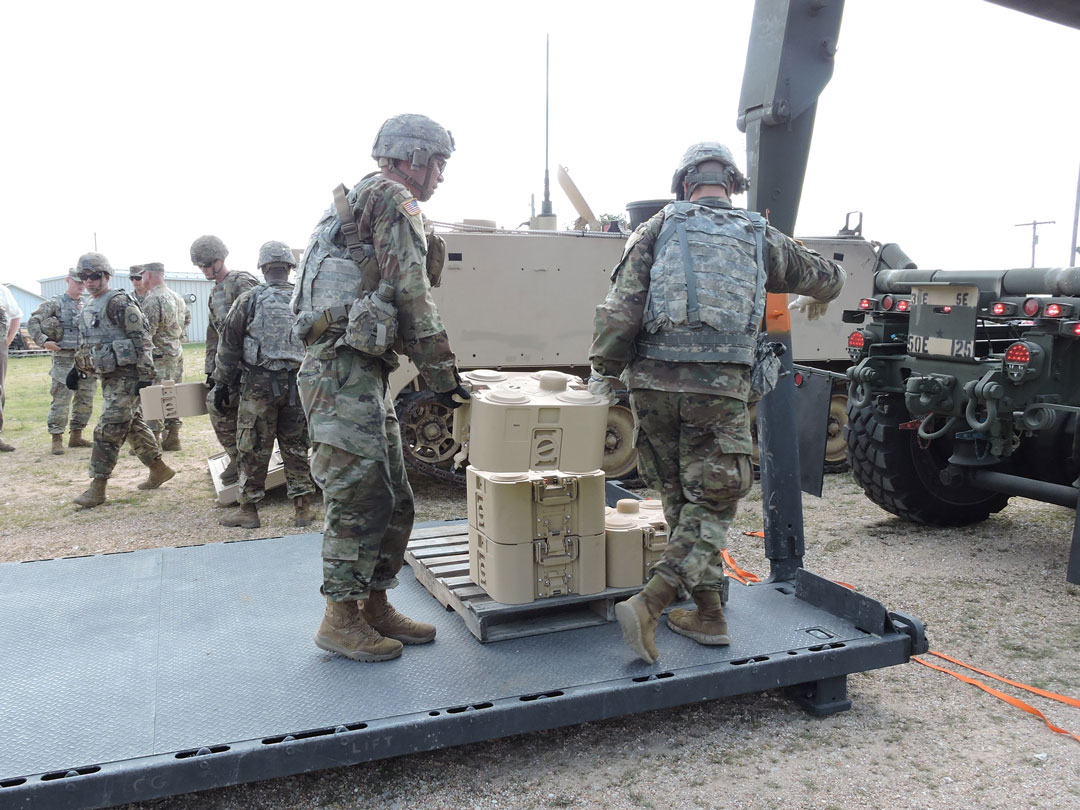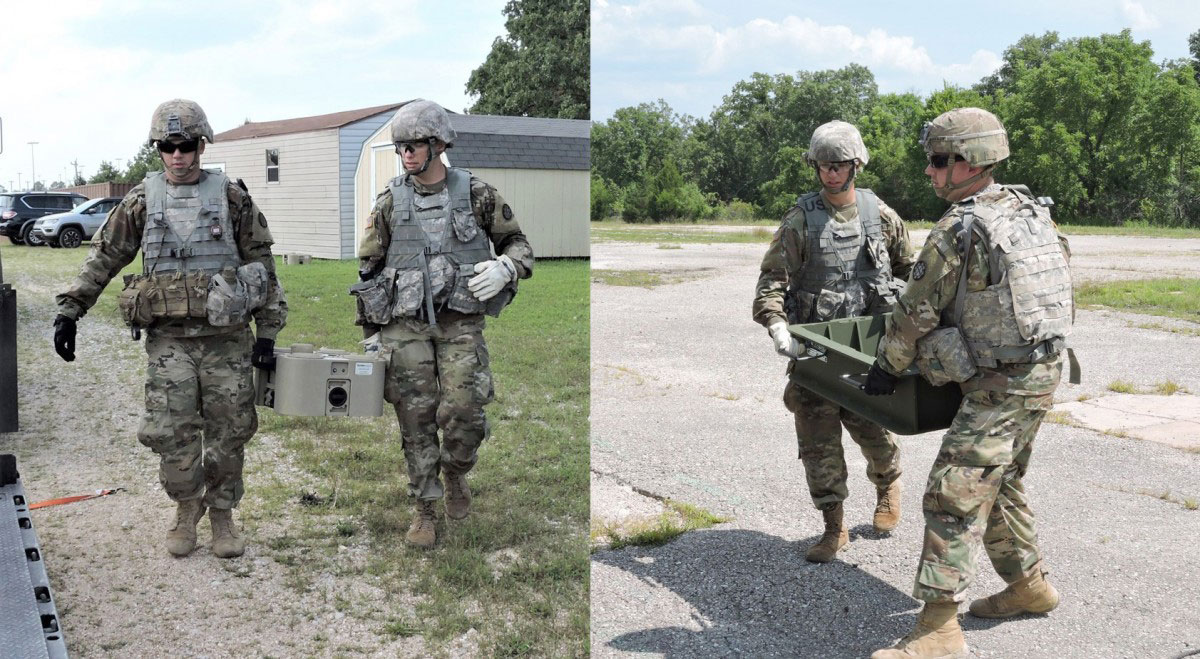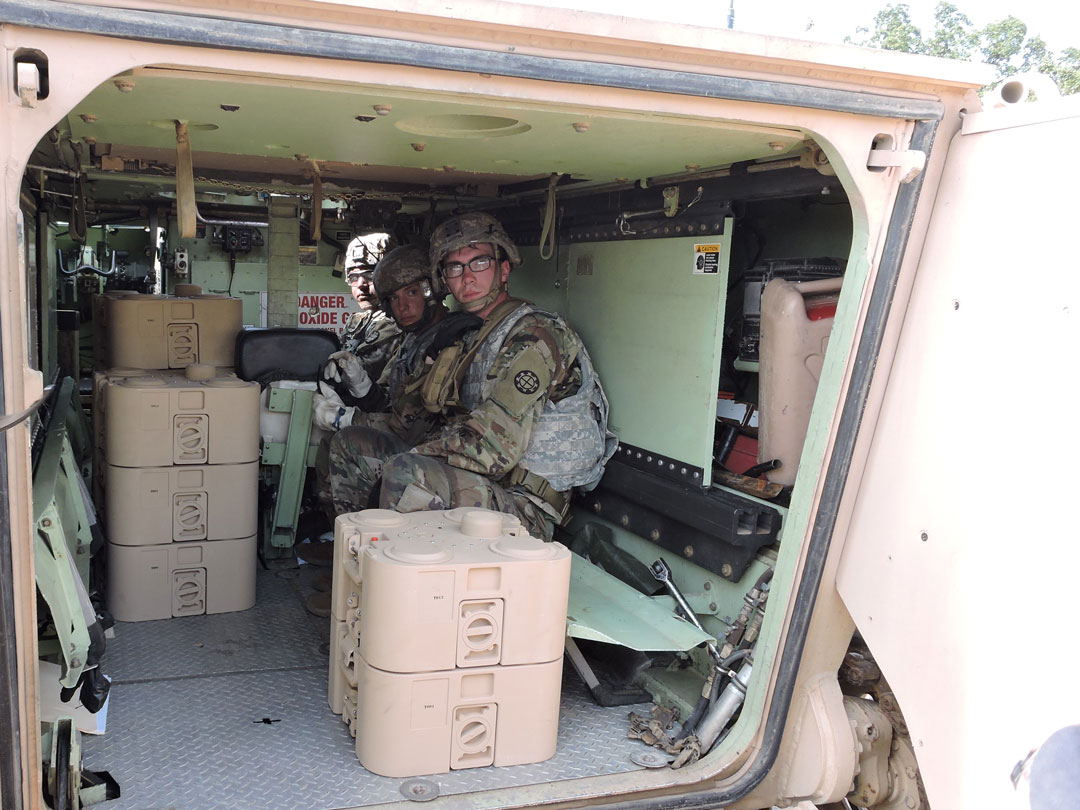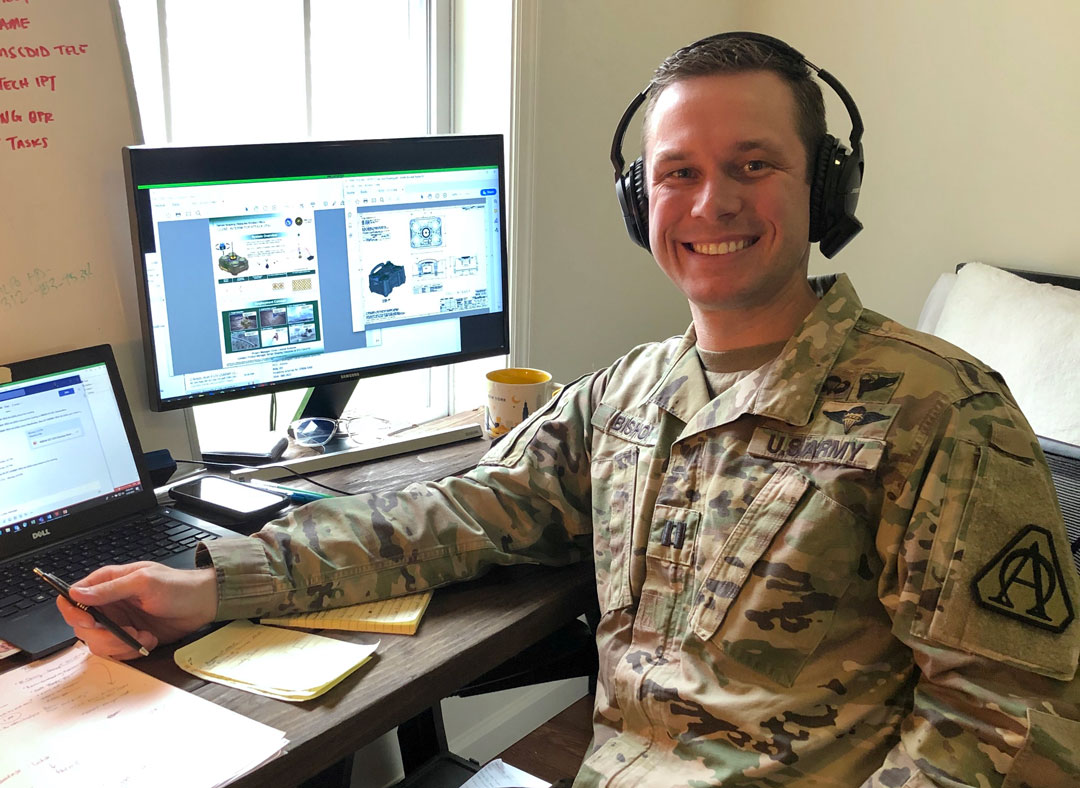
EXAMINING THE GOODS: A Soldier from the 595th Sapper Company looks at the TSO dispenser launcher modules in the back of a M113 in support of a Soldier Touch Point for PM CCS/Product Manager TSO. (Photo by Marc A. Krauss, JPEO A&A)
A JPEO A&A team developed a novel approach to conducting a system review, to stay on schedule in the face of social distancing restrictions.
by Stephen McFarlane and Capt. Harold “Trey” Bishop
In alignment with the Army modernization priority for enhanced mines and munitions area-denial capabilities, the Project Manager for Close Combat Systems (PM CCS) within Joint Program Executive Office for Armaments and Ammunition (JPEO A&A) located at Picatinny Arsenal, New Jersey, is developing the Wide Area Munition, XM204 Top Attack. The munition will enhance the Soldiers’ ability to shape the terrain with the construction of complex obstacles.
The XM204 Top Attack project team began in late February conducting the planning and preparation for the “typical” face-to-face system requirements review and system functional review. However, on March 12, 2020 the team was advised that all near term and future travel was restricted owing to the coronavirus pandemic. The COVID-19 social restrictions presented the project team the challenge of finding an alternative way to execute this major system engineering review, with up to 80 participants, in a remote manner using a computer-based virtual communication application or run the risk of falling behind schedule in developing this critical capability.

LOAD ‘EM UP: Soldiers from the 595th Sapper Company load TSO dispenser launcher modules onto a Palletized Load System truck in support of a Soldier Touch Point for PM CCS/Product Manager TSO. (Photo by Marc A. Krauss, JPEO A&A)
THE CHALLENGE
The XM204 development program scheduled a system requirements review combined with a system functional review in early April 2020. The system requirements review is a formal review between the prime contractor and the government to ensure a complete and mutual understanding of system requirements. The system requirements review ensures that the XM204 Top Attack system can proceed into initial systems development and that all system and performance requirements are defined and testable, are consistent with cost, schedule, risk, technology readiness and other system constraints. The system functional review is a technical review to ensure that the system’s functional baseline is established and can satisfy the requirements within the currently allocated budget and schedule. These reviews typically occur before technologies have matured, in an effort to complete a preliminary design.

PROTOTYPE TEST DRIVE: Soldiers from the 595th Sapper Company, 5th Engineer Battalion, participate in the evaluation of two terrain-shaping obstacle prototypes July 24-25, 2019 at Fort Leonard Wood, Missouri. JPEO A&A is working to develop this capability through its Close Combat Support program. (U.S. Army photo)
Imagine you’re in a small contingent of Soldiers—a squad or platoon element—in in the field. The enemy is due north and will be approaching your location with heavy tracked vehicles. Reinforcements are a couple of days out, so you must alter the enemies’ path of travel or they will find your position and you will be overrun. You have several XM204 Top Attack munition systems at your disposal and have decided to set up an obstacle. Obstacles are a means to limit the enemy’s ability to maneuver and can be composed of ditches, wire, natural terrain restrictions and lethal munitions. In this case, you have decided to go with the lethal munitions option. The XM204 Top Attack will cause the enemy to reconsider their operational advance due to the risk or realization of costly casualties if they continue down a path of travel that will lead them directly to your location.
After hand emplacement of the obstacles, you hightail it far outside the munitions effective range while leaving reconnaissance elements to maintain watch over the obstacles. Several hours later, your over watch element confirms that multiple XM204 Top Attack munition systems launched sub-munitions that effectively engaged enemy vehicles, causing extensive damage and resulting in the enemy having to change directions. Mission accomplished. The emplaced obstacle effectively shaped the terrain, resulting in enemy maneuver in a direction that gives your Soldiers sufficient time for reinforcements to arrive.

AWAITING TESTING: Palletized TSO dispenser launcher modules on a Palletized Load System truck prior to road test in support of a Soldier Touch Point for PM CCS/Product Manager TSO (Photo by Marc A. Krauss, JPEO A&A)
THE SOLUTION
The project team conducted an expedient analysis of alternatives to evaluate the best virtual tool to effectively enable contractor-to-government presentation of materials and joint collaboration. The project team ultimately selected the Federal Risk and Authorization Management Program (FedRAMP) approved version of WebEx. However, this didn’t solve the problem of ensuring that everyone received and understood all the briefing materials in support of the review. The team developed a novel approach to conducting a virtual conference that would ensure panel members received timely information sufficient to conduct full assessments of the system requirements review and system functional review entrance and exit criteria. In advance of the event, the team supplied:
- Briefing packages with embedded audio narration.
- Solicited questions from review panel members, pertaining to the briefing packages and provided responses.
- Training sessions with FedRAMP approved version of WebEx.
- Customized templates for capture, organization and dissemination of questions and answers from the entire team prior to the conference.
These four keys were of the utmost importance in conducting a virtual meeting of this size and importance. The delivery of audio-enhanced briefings, audio added via a built-in Microsoft PowerPoint feature, before the event provided sufficient narrative detail to enable a cursory review of the information during the actual review. The pre-event capture and response to panel member questions reduced the amount of time that would be required for questions and answers during the event. The pre-event training and familiarization events with the WebEx virtual tool enabled a majority of the team to hit the ground running with all participants fully operational within the first half hour of the first day. The customized templates for questions and answers enhanced the delivery of multi-field sortable information to inform panel member understanding of the material presented.

HAVING A REST: Soldiers from the 595th Sapper Company sit beside TSO dispenser launcher modules in the back of a M113 in support of a Soldier Touch Point for PM CCS/Product Manager TSO. (Photo by Marc A. Krauss, JPEO A&A)
In addition, the project team developed and distributed planned event rules of engagement to ensure orderly communication and sharing of information. The rules specified that microphones should be muted as a default and instructed participants not to place calls on hold because of built-in hold music that is a distraction to others on the line. They also noted how presentations would be delivered, how the host would manage the information that must be shared with the team, how team members would use the chat function and contingency communications for those unable to access the web based application for viewing of briefing information.
The XM204 integrated product team implemented an ambitious plan of completing the planned face-to-face three day review in a one and a half day virtual review. The execution of this meeting required three primary roles; 1) a knowledgeable host to facilitate the discussion, 2) an assistant host who managed screen share with attendees and 3) a note taker.
The first day of the review began with a 30-minute sign-in session to ensure team members were able to access WebEx via web browser (preferred) or solely by telephone audio (not preferred). The team achieved 100 percent sign in with time to spare before moving on to the briefing packages.
For each briefing package, the host announced the slide deck and the briefer. The briefer provided a five-minute executive summary of the material covered in the briefing. Then the briefer answered questions from the review panel members and program leaders. Subsequently the reviewed actions were captured and the process was repeated for all other briefs. This format enabled the review of 17 briefing packages between 8:30 a.m. and 4:00 p.m. on the first day.
The second day’s activities included a panel member break-out session to assess the XM204 program in accordance with the system requirements review and system functional review entrance and exit criteria, as well as a separate system requirement document review. The panel break-out session balanced multiple perspectives and information; with representation from industry, the U.S. Army Combat Capabilities Development Command, the PM CCS project management office and JPEO A&A. The separate program team review of the requirements document ensured understanding of the system requirements at the lowest level of detail.
Following the review and break-out session, the panel chair briefed the program team on the panel’s assessment of the system requirements review and system functional review entrance criteria and exit criteria. The assessment included a detailed synopsis of the whether criteria was met, partially met, or not met. The end result?
The panel provided concurrence on successful completion of the system requirements review and system functional review! The successful completion of this key program activity can largely be attributed to the team’s preparation. “Your preparation and upfront attention to detail worked to make the system requirements review and system functional review a success,” said Joe Pelino, acting project manager for Close Combat Systems, praising the team. The XM204 project team captured pre-event preparation tasks and post-event lessons learned into a single briefing package that was disseminated throughout the JPEO A&A.

FRONT ROW SEATS: Capt. Harold “Trey” Bishop, assistant product manager for Terrain Shaping Obstacles (TSO), monitors the virtual system requirements review and system functional review in April. TSO utilized available technology to quickly convert the exhaustive three-day, in-person review to an online event. (U.S. Army photo courtesy of JPEO A&A)
CONCLUSION
The XM204 project team successfully completed the key System Engineering Reviews, system requirements review and system functional review in the midst of COVID-19 related challenges. Ken Heider, acting product manager for Terrain Shaping Obstacles stated “I was very pleasantly surprised with how well we were able to execute the review under the current circumstances.” The XM204 development contractor is now well positioned to proceed into preliminary design completion. The next major scheduled review is the preliminary design review. The system requirements review and system functional review events set the foundation for the rest of the development and the success of the program.
For more information, contact Stephen McFarlane at stephen.r.mcfarlane.civ@mail.mil or Capt. Bishop at harold.j.bishop6.mil@mail.mil.
STEPHEN MCFARLANE is a project officer for Terrain Shaping Obstacles (TSO) within the CCS project office at JPEO A&A. McFarlane holds an M.S. in mechanical engineering from Stevens Institute of Technology in Hoboken, New Jersey and a B.S. in mechanical engineering from Lafayette College in Easton, Pennsylvania.
CAPT. HAROLD “TREY” BISHOP is assistant product manager for Terrain Shaping Obstacles (TSO) within the Close Combat Systems project office at JPEO A&A. He holds a bachelor’s of business administration in finance from Texas A&M University.
Read the full article in the Summer 2020 issue of Army AL&T magazine.
Subscribe to Army AL&T News – the premier online news source for the Army Acquisition Workforce.







